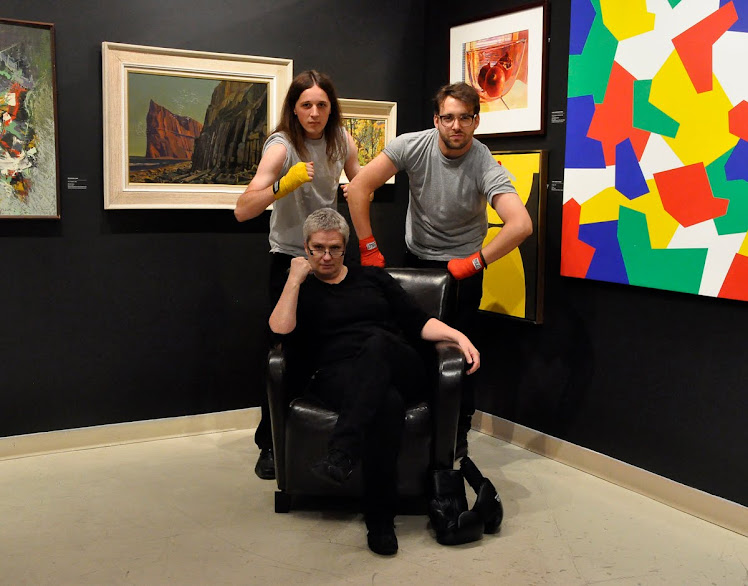
Cam admiring a thoughtful selection...
Frances Ferdinands
The Space Between, 1986
52 1/8" x 78 1/4"
Acrylic on canvas with xerography
Purchased from the artist
Rack 8. Coming off of the long weekend, a nice three day breather, it was time to step into the second half of the Smackdown. I drew a rack from the karmic coffee tin, which has been something of a rarity thus far in the competition. The racks are almost always exciting, with each one usually having quite a range in work by ways of content, scale, and age. However, with all of these possibilities, I ended up having a hard time making this decision.
The first problem is that Rack 8 is also home to two Louis de Niverville paintings; two of my favorite in collection. With this in mind, upon pulling out the rack to survey the possibilities, I had to continually put the de Niverville's back in check. I did not want to make a decision based mostly on the fact that I like the work. Liking something, and including something that you like because it makes sense in the exhibition are definitely two different things. Of course, before I made my final decision I had to bring the de Niverville out and see how it felt within the exhibition, only to have my initial feelings confirmed. These paintings will be staying on Rack 8 for now...

The next painting that I brought out was a nice, energetic, airy watercolour by Denise Ireland. It still had some of the sketch lines visible on the paper, and dealt with colour in a very similar way to some of these abstract works that have been coming out. I thought that it would challenge me to pick something that I wouldn't normally be attracted to, and try to give it a fair chance. So I brought the painting out and started doing some reading about the artist, but it just didn't feel right. I don't know if the pencil marks showing through the paint, or the way the paper sat in the frame, or even the way the work reacted on the green wall, but something just didn't feel right. So away it went...
Ultimately, there were a few more decisions that followed along a similar pattern, with each work eventually working itself back onto Rack 8. It is interesting though, that each of the works on the rack could have possibly fit within some dimension of this exhibition. Whether that is a strength of the works or an ambiguity within the exhibition is interesting to consider.
So, with that, I eventually settled on a large canvas by Frances Ferdinands. Born in Sri Lanka, Ferdinands is now based in Toronto. She received her degree in Visual Art from York University and in Education from University of Toronto. As a young art student she was already a recognized Toronto author. In 1973 she co-edited the book Eclectic Eve, a collection of over 50 interviews with 'Toronto Women artists' that was met with much praise.
This work seems to pick up a number of different threads, even if it is somewhat inconclusive on any particular view. The idea of nationalism and its representation is starting to expand and take on more of an international consideration. This is provoked by the strong national symbol of the American flag stuck to the arm of the astronaut floating in space. While I don't think (personally), that the artist intended a nationalist reading of this work, it can't help but develop that theme in the context of this Smackdown.
Ferdinands work is often highly symbolic. Everything seems to represent something, even if it takes some time to get past the compositional elements. For example, cows make a frequent appearance in her work as a stand-in for nature and the natural. Placed on this strict one-point perspective grid, the geometric and technological are all of a sudden underpinning the natural. This collision of the natural with the technological, digital, geometric (read: man made) world is made very clear.
The xerography that Ferdinands included was the image of God giving life to the tip of Adams finger, the iconic image from the cieling of the Sistine Chapel originally painted by Michelangelo. Represented here though, the two fingers never meet. A sharp red arrow seems to keep Gods finger from going any further, while Adam seems to be reaching desparately for the telephone. Regardless of any one view on these decisions, the allusion to the interjection of the technological into our natural, or even spiritual, worlds is obvious. This relationship has been developed to some extent in the rest of the exhibition, with a couple of selections now referencing the interplay between the natural and technological, man-made world.
In the end, I found the chance to interact with a work that I never had that initial attachment to. I found a suitable spot in an exhibition that allows closer consideration of works, and while the work still may not be my own personal favorite in the collection, I can certainly now appreciate how a work of art can function so differently within a context. This context includes the other art around the walls, but also the wall colour, lighting, and everything else! I'm looking forward to Day 5 of this Smackdown, things are getting tight, themes are getting developed, and the show is starting to pull together. Pressure's on!
Darryn
 Harvey, Donald
Harvey, Donald
 Boyle, John
Boyle, John
 The walls were still looking pretty bare after the first day. There didn't seem to be much happening between the works or in the space. Day 2 could prove to be challenging for our curatorial contenders.
The walls were still looking pretty bare after the first day. There didn't seem to be much happening between the works or in the space. Day 2 could prove to be challenging for our curatorial contenders. 













































